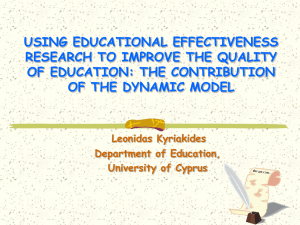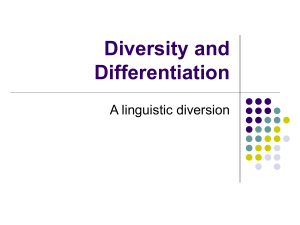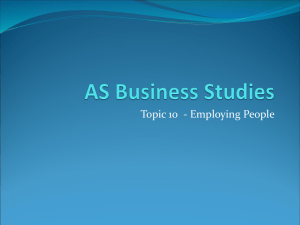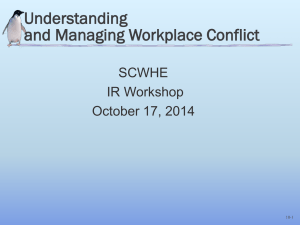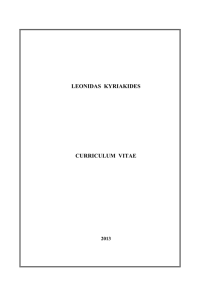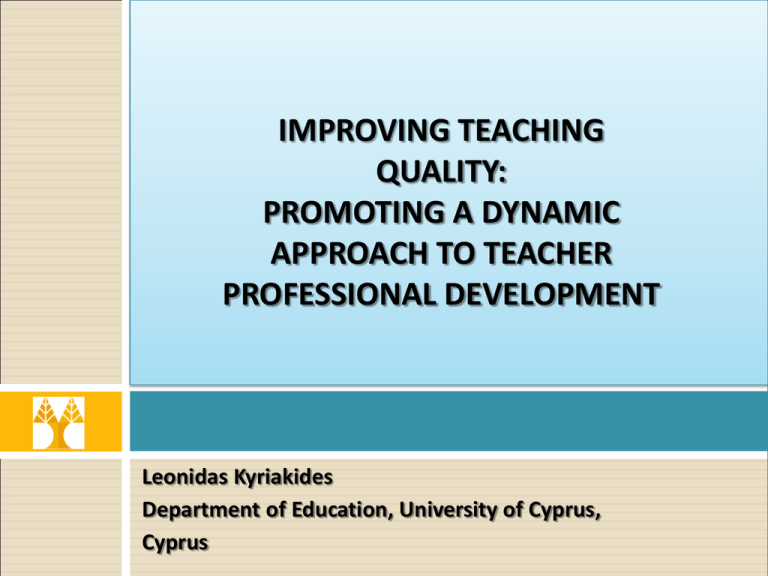
IMPROVING TEACHING
QUALITY:
PROMOTING A DYNAMIC
APPROACH TO TEACHER
PROFESSIONAL DEVELOPMENT
Leonidas Kyriakides
Department of Education, University of Cyprus,
Cyprus
INTRODUCTION
Research has consistently shown that:
the
classroom level can explain more of the variance
in pupil outcomes than the school level, and
a
large proportion of this classroom level variance can
be explained by what teachers do in the classroom.
INTRODUCTION
This presentation aims to
summarize key findings and developments in the area of
TER
discuss the main methodological and conceptual
limitations of TER
refer to recent developments in TER which reveal the
importance of identifying grouping of teacher factors
associated with student achievement
propose a dynamic approach to teacher professional
development
present findings of experimental studies supporting its use
for improvement purposes
MAJOR FINDINGS OF TEACHER EFFECTIVENESS
RESEARCH
1.
During the last 35 years, researchers have turned to teacher
behaviour as predictor of student achievement in order to
build up a knowledge base on effective teaching.
Quantity and pacing of instruction (Amount learnt is related
to opportunity to learn.)
Achievement is maximised when teachers prioritise academic
instruction and allocate available time to curriculum-related
activities.
Effective teachers organise and manage the classroom
environment as an efficient learning environment and thereby
maximise engagement rates
Although there is a great deal of teacher talk in the classes of
effective teachers, most of it is academic rather than managerial
or procedural.
MAJOR FINDINGS OF TEACHER EFFECTIVENESS
RESEARCH
2.
Form and quality of teacher's organised lessons (Giving
information – structuring; asking questions (soliciting); and
providing feedback)
Structuring factor: a) outlining the content to be covered
and signalling transitions between lesson parts; b) calling
attention to main ideas; and c) reviewing main ideas at the
end.
Summary reviews are important since they integrate and
reinforce the learning of major points.
MAJOR FINDINGS OF TEACHER EFFECTIVENESS
RESEARCH
2.
Form and quality of teacher's organised lessons (Giving
information – structuring; asking questions (soliciting); and
providing feedback)
Clarity of presentation: Effective teachers communicate
clearly and directly with their students.
Effective teachers ask a lot of questions and attempt to
involve students in class discussion.
There should also be a mix of product and process
questions.
Effective teachers also use seatwork or small group tasks
since they provide needed practice and application
opportunities.
MAJOR FINDINGS OF TEACHER EFFECTIVENESS
RESEARCH
3.
Classroom climate is a significant teacher factor.
teacher-student interaction,
student-student interaction,
students’ treatment by the teacher,
competition between students,
and classroom disorder.
The first two elements are important components of
measuring classroom climate, as classroom environment
research has shown (Cazden 1986; den Brok, Brekelmans, and
Wubbels 2004; Fraser 1991).
The other three elements refer to the attempt of teachers to
create a businesslike and supportive environment for
learning.
CONCEPTUAL AND METHODOLOGICAL
LIMITATIONS OF TER
1.
Most effectiveness studies are exclusively focused on
language or mathematics rather than on the whole school
curriculum.
EER should take into account the new goals of education
and related to this their implications for teaching and
learning.
New theories of teaching and learning should be used in
order to specify variables associated with the quality of
teaching.
Recent models of teaching and learning characterize
learning as a self-regulated and constructive process
(Bransford, Brown, and Cocking 2000; Collins, Brown, and
Newman 1989).
CONCEPTUAL AND METHODOLOGICAL
LIMITATIONS OF TER
During the last decade, this characterization of teaching
stimulated a substantial number of studies which
investigate the impact of new learning approaches to
teaching on student outcomes (e.g., Brush 1997; Nolen
2003; Fuchs, Fuchs, Yazdian, and Powell 2002; Ramsden
1997).
Two recent meta-analyses (Seidel and Shavelson 2007;
Kyriakides and Christoforou 2011) revealed that instead of
treating active and direct teaching approaches as in
contrast with the new leaning approaches to teaching, an
integrated approach to teaching should be adopted.
CONCEPTUAL AND METHODOLOGICAL
LIMITATIONS OF TER
The dynamic model advocates for the use of an integrated
approach in defining quality of teaching and refers to
those teacher factors that were related with student
achievement irrespective of whether they are in line with
one or the other approach to teaching (Creemers and
Kyriakides 2008).
The model is in line with those indicating the limitations of
using exclusively either the direct teaching approach
(Steffe and Gale 1995) or approaches associated with
constructivism (Kirschner, Sweller, and Clark 2006) to
describe effective teaching.
CONCEPTUAL AND METHODOLOGICAL
LIMITATIONS OF TER
2.
TER does not contribute significantly to teachers'
professional development or to improving teachers'
effectiveness.
Research on teacher training and research on teacher
effectiveness have been conducted apart from and without
much reference to one another (Creemers, Kyriakides &
Antoniou, 2013).
Few researchers of teacher training methods rationalize their
selection of teaching skills in terms of TER and very few
evaluate the impact of teacher professional development on
student learning.
Investigators of teacher effectiveness spend little time
speculating about the methods that may be used to improve
teaching practice.
CONCEPTUAL AND METHODOLOGICAL
LIMITATIONS OF TER
The dynamic model of educational effectiveness
has been developed in order to establish stronger
links between effectiveness research and
improvement of practice (Creemers and Kyriakides
2006).
THE DYNAMIC MODEL OF EDUCATIONAL
EFFECTIVENESS: AN OVERVIEW
The dynamic model refers to multiple factors of
effectiveness which operate at different levels
(figure 1).
The teaching and learning situation is emphasized
and the roles of the two main actors (i.e., teacher
and student) are analyzed.
Figure 1: The
Dynamic
Model of
Educational
Effectiveness
THE DYNAMIC MODEL OF EDUCATIONAL
EFFECTIVENESS: AN OVERVIEW
Although there are different effectiveness factors, each factor
can be defined and measured using five dimensions:
frequency, focus, stage, quality, and differentiation.
These dimensions help us describe in better way the
functioning of a factor.
The five dimensions are not only important for a
measurement perspective but also and even more for a
theoretical point of view.
The use of these dimensions may help us develop strategies
for improving teaching since the feedback given to teachers
could refer not only to quantitative but also to qualitative
characteristics of their teaching practice.
THE DYNAMIC MODEL OF EDUCATIONAL
EFFECTIVENESS: AN OVERVIEW
The dynamic model refers to factors which describe teachers’
instructional role and are associated with student outcomes.
The eight factors included in the model are as follows (see table 1):
orientation,
structuring,
questioning,
teaching-modeling,
applications,
management of time,
teacher role in making classroom a learning environment, and
classroom assessment.
Table 1:The main elements of each teacher factor included in
the dynamic model
Factors
Main elements
1) Orientation
a) Providing the objectives for which a specific task/lesson/series of lessons take(s) place; and b)
challenging students to identify the reason why an activity is taking place in the lesson.
2) Structuring
a) Beginning with overviews and/or review of objectives; b) outlining the content to be covered
and signalling transitions between lesson parts; and c) drawing attention to and reviewing main
ideas.
a) Raising different types of questions (i.e., process and product) at appropriate difficulty level; b)
giving time for students to respond; and c) dealing with student responses.
3) Questioning
4)Teaching
modelling
a) Encouraging students to use problem solving strategies presented by the teacher or other
classmates; b) inviting students to develop strategies; and c) promoting the idea of modelling.
5) Application
a) Using seatwork or small group tasks in order to provide needed practice and application
opportunities; and b) using application tasks as starting points for the next step of teaching and
learning.
6) The classroom a) Establishing on task behaviour through the interactions they promote (i.e., teacher-student and
as a learning
student-student interactions); and
environment
b) Dealing with classroom disorder and student competition through establishing rules,
persuading students to respect them and using the rules.
7) Management
of time
8) Assessment
a) Organising the classroom environment; and b) Maximising engagement rates.
a) Using appropriate techniques to collect data on student knowledge and skills; b) analysing data
in order to identify student needs and report the results to students and parent; and c) evaluating
their own practices.
THE DYNAMIC MODEL OF EDUCATIONAL
EFFECTIVENESS: AN OVERVIEW
The model is based on the assumption that teaching factors are
not separate entities but some of them are interrelated (i.e.,
refers to grouping of factors).
Three recent studies (Kyriakides, Creemers, and Antoniou 2009;
Janosz, Archambault, and Kyriakides 2011; Antoniou & Kyriakides,
2011) provided support to this assumption.
The teaching skills included in the dynamic model were grouped
into 5 stages. These were situated in a developmental order and
linked with student outcomes (see figure 2).
Teachers who demonstrated competencies in the higher stages
were found to be more effective than those situated at the lower
stages.
DEVELOPMENTAL STAGES OF TEACHING SKILLS
LEVEL 5
Kyriakides, Creemers & Antoniou (2009)
Antoniou (2010)
LEVEL 4
LEVEL 3
LEVEL 2
LEVEL 1
1)Frequency management
time
2) Stage Management of time
3) Frequency structuring
4) Frequency Application
5) Frequency Assessment
6) Frequency Questioning
7) Frequency teacher-student
relation
LEVEL 1 SKILLS
1) Stage Structuring
2) Quality Application
3) Stage Questioning
4) Frequency student relations
5) Focus Application
6) Stage Application
7) Quality of questions
LEVEL 1 & 2 SKILLS
1) Stage student relations
2) Stage teacher-student
relation
3) Stage Assessment
4) Frequency Teaching
Modelling
5) Frequency Orientation
6) Focus student relations
7) Quality: feedback
8) Focus Questioning
9) Focus teacher-student
relation
10) Quality structuring
11) Quality Assessment
LEVEL 1, 2 & 3 SKILLS
1) Differentiation
Structuring
2) Differentiation time
management
3) Differentiation
Questioning
4) Differentiation
Application
5) Focus Assessment
6) Differentiation
Assessment
7) Stage teaching
modelling
8) Stage orientation
LEVEL 1, 2,3 & 4 SKILLS
1) Quality teacherstudent relation
2) Quality student
relations
3) Dif teacher-student
relation
4) Differentiation student
relations
5) Focus Orientation
6) Quality Orientation
7) Differentiation
Orientation
8) Quality of teaching
modelling including
differentiation
9) Focus Teaching
Modelling
THE DYNAMIC MODEL OF EDUCATIONAL
EFFECTIVENESS: AN OVERVIEW
The first three levels are related to the direct and active teaching
approach, by moving from the basic requirements concerning
quantitative characteristics of teaching routines to the more
advanced requirements concerning the appropriate use of these
skills as these are measured by the qualitative characteristics of
these factors.
These skills also gradually move from the use of teacher-centred
approaches to the active involvement of students.
The last two levels are more demanding since teachers are
expected to differentiate instruction (level 4) and demonstrate
their ability to use the new teaching approach (level 5).
These five stages advance on previous stage models by specifically
determining the content of each stage (in terms of teaching skills),
whereas previous stage models often lacked clarity on what might
constitute each developmental stage.
IMPLICATIONS FOR TEACHER PROFESSIONAL
DEVELOPMENT
A question raised is the extent to which teachers can move
from one stage of teaching competence to the next, by
improving their teaching skills and ultimately their student
achievement gains.
The dynamic approach lies between the two dominant
approaches to teacher professional development (i.e., the
CBA and the HA) and aims to overcome their main
weaknesses.
CBA: Program requirements are stated as competencies which
describe what the teacher must demonstrate for successful
completion of the program.
HA: Promotes reflection of teaching practices, experiences, and
beliefs. Reflective practitioners can handle their improvement
based solely on their own experiences and critical thinking.
IMPLICATIONS FOR TEACHER PROFESSIONAL
DEVELOPMENT
The content derives from the grouping of teaching skills
included in the dynamic model and it is differentiated to
meet the needs and priorities of teachers at each
developmental stage.
Although the content of this approach refers to teaching skills
that were found to be positively related with student
achievement, the participants are also engaged into
systematic and guided critical reflection on their teaching
practices.
A STUDY INVESTIGATING THE IMPACT OF THE
DYNAMIC APPROACH ON IMPROVING TEACHING AND
STUDENT LEARNING OUTCOMES
Participants: A total of 130 primary teachers volunteered to
participate in the professional development programme.
Data were collected for all students (n=2356) of the teacher-sample
both at the beginning and end of the intervention.
Phase 1: Teaching skills were evaluated by external observers.
Teachers were classified into the same five levels mentioned above
Phase 2: The teachers at each developmental stage were randomly
allocated into two groups.
The first group employed the dynamic approach while the second
group used the HA.
A STUDY INVESTIGATING THE IMPACT OF THE
DYNAMIC APPROACH ON IMPROVING TEACHING AND
STUDENT LEARNING OUTCOMES
Phase 3: Teachers of each group began to work towards
improving their teaching skills.
i) Sessions for teachers employing the Dynamic Approach
Teachers employing the DA were assigned to four groups
according to the stage in which they were found to be situated.
Supporting literature and research findings related with the
teaching skills which correspond to their stage were provided.
The area on which each group had to concentrate their efforts
for improvement was made clear.
A STUDY INVESTIGATING THE IMPACT OF THE
DYNAMIC APPROACH ON IMPROVING TEACHING AND
STUDENT LEARNING OUTCOMES
Each teacher developed his/her own action plan by
exchanging ideas with the research team and members of
his/her group.
One session per month was scheduled until the end of the
school year.
The monthly sessions were organized in groups (based on
teachers´ stages)
Researchers visited teachers at their schools to discuss
emergent issues related with the implementation of their
action plans into their teaching practice and provide
feedback to the teachers.
A STUDY INVESTIGATING THE IMPACT OF THE
DYNAMIC APPROACH ON IMPROVING TEACHING AND
STUDENT LEARNING OUTCOMES
ii) Sessions for teachers employing the HA
Primary aim: Help individuals to critically evaluate their own
beliefs and practice and help them transform their experiences
from a past event to an ongoing learning process.
Teachers had the chance to discuss in groups, identify a problem
which they considered important in their teaching and formulate a
plan of action to tackle this problem.
After the development of the teachers’ initial action plans, we
scheduled one session per month until the end of the school year.
This decision provided the teachers with sufficient time to
implement the activities included in their action plans and to
reflect on the effectiveness of these activities.
A STUDY INVESTIGATING THE IMPACT OF THE
DYNAMIC APPROACH ON IMPROVING TEACHING AND
STUDENT LEARNING OUTCOMES
Results:
The dynamic approach was more effective than the HA in
improving teaching skills.
The final scores of teachers employing the DA (Mean=0.36,
SD=1.05) were higher than initial scores (Mean=-0.28, SD=1.01)
and this difference was statistically significant (t=4.14, df=64,
p<.001).
The final scores of teachers employing the HA (Mean=-0.25,
SD=1.04) were not higher than their initial scores (Mean=-0.26,
SD=1.05) and paired samples t-test show that teachers employing
the HA did not make any statistically significant progress (t=0.87,
df=64, p=0.38).
None of the teachers employing HA moved from one stage to
another.
Employing the DA had a statistically significant effect on
student achievement, compared with employing the HA (see
Table 2).
Table 2: Parameter Estimates and (Standard Errors) for the
analysis of student achievement in maths (Students within
classes, within schools)
Factors
Model 0
Model 1
Model 2
Model 3
Model 4
Model 5
Fixed part (Intercept)
Student level
Context
Prior achievement in maths
Grade 3
Grade 4
Grade 6
Sex (0=Girls, 1=Boys)
SES
Cultural capital
Opportunity to learn
Homework
Private tuition (0 =no, 1=yes)
Classroom level
Context
Average achievement in maths
Average SES
Average cultural capital
Percentage of girls
Teacher background
Gender (0=male, 1=female)
Years of experience
Position
5.19 (0.80)
4.10 (0.78)
3.80 (0.80)
3.70 (0.90)
2.90 (0.80)
2.10 (0.80)
0.80 (.12)
-1.20 (.40)
-0.72 (.30)
0.65 (.30)
0.10 (.04)
0.40 (.14)
0.19 (.08)
0.79 (.12)
-1.09 (.40)
-0.66 (.30)
0.64 (.30)
0.10 (.04)
0.41 (.14)
0.19 (.09)
0.81 (.12)
-1.08 (.40)
-0.62 (.30)
0.64 (.30)
0.11 (.04)
0.40 (.14)
0.20 (.08)
0.80 (.11)
-1.10 (.40)
-0.63 (.30)
0.65 (.30)
0.10 (.04)
0.41 (.14)
0.18 (.08)
0.80 (.12)
-1.07 (.40)
-0.62 (.30)
0.66 (.30)
0.09 (.04)
0.40 (.14)
0.18 (.08)
0.12 (.04)
N.S.S.
0.12 (.04)
N.S.S.
0.12 (.04)
N.S.S.
0.12 (.04)
N.S.S.
0.40 (.10)
N.S.S.
N.S.S.
N.S.S.
0.40 (.10)
N.S.S.
N.S.S.
N.S.S.
0.40 (.10)
N.S.S.
N.S.S.
N.S.S.
0.40 (.10)
N.S.S.
N.S.S.
N.S.S.
N.S.S.
0.08 (.03)
N.S.S.
N.S.S.
N.S.S.
N.S.S.
N.S.S.
N.S.S.
N.S.S.
0.40 (.10)
N.S.S.
N.S.S.
N.S.S.
Factors
Model 0
Model 1
Model 2
Model 3
Model 4
Model 5
Level 1
-0.52 (.09)
-0.51 (.09)
Level 2
-0.24 (.09)
-0.25 (.09)
Level 4
0.32 (.10)
0.32 (.10)
Quality of teaching
Experimental group
1=competence based)
(0=only
reflection,
0.24 (.08)
School Level
Context
Average achievement in maths
0.09 (.04)
0.10 (.04)
0.08 (.04)
0.10 (.04)
0.09 (.04)
Average SES
N.S.S.
N.S.S.
N.S.S.
N.S.S.
N.S.S.
Average cultural capital
N.S.S.
N.S.S.
N.S.S.
N.S.S.
N.S.S.
Percentage of girls
N.S.S.
N.S.S,
N.S.S,
N.S.S,
N.S.S,
Variance components
School
10.2%
10.0%
9.8%
9.5%
9.1%
8.5%
Class
18.5%
17.6%
17.2%
16.0%
11.0%
9.0%
Student
72.3%
49.0%
45.0%
44.3%
44.1%
44.0%
23.4%
28.0%
30.2%
35.8%
38.5%
687.3
650.1
590.1
520.0
480.5
526.1
37.2
60.0
70.1
39.5
9
1
2
2
1
.001
.001
.001
.001
.001
Explained
Significance test
Χ2
Reduction
Degrees of freedom
p-value
1213.4
CONCLUSIONS - SUGGESTIONS
Improvement of teacher effectiveness cannot be focused
solely on the acquisition of isolated skills or competencies,
or on reflection across the whole teaching process to help
teachers get “greater fulfilment as a practitioner of the art”
(of teaching).
Reflection is more effective when teachers' priorities for
improvement are taken into account, and when they are
encouraged to develop action plans which address their
professional needs.
Teachers employing the HA adopted a less focused reflection
strategy, which allowed teachers to reflect on any aspect of
their teaching practice irrespective of the stage on which they
were situated.
CONCLUSIONS - SUGGESTIONS
Thinking and critical analysis are important, and thus those
aspects of the HA were utilised in the development of the DA.
Complimenting reflection with the knowledge-base of EER, which
addresses the needs of specific groups of teachers, could help
establish effective approaches to teacher professional
development which will have an impact on improving learning
outcomes.
Further research is needed to test the generalizability of the
findings of these studies and contribute in the further
development of the dynamic approach to teacher professional
development.
Further research can raise the importance of addressing not only
the teacher but also the school factors through a dynamic
approach which may ultimately have an impact on promoting both
quality and equity in education.
Thank you for your attention!


